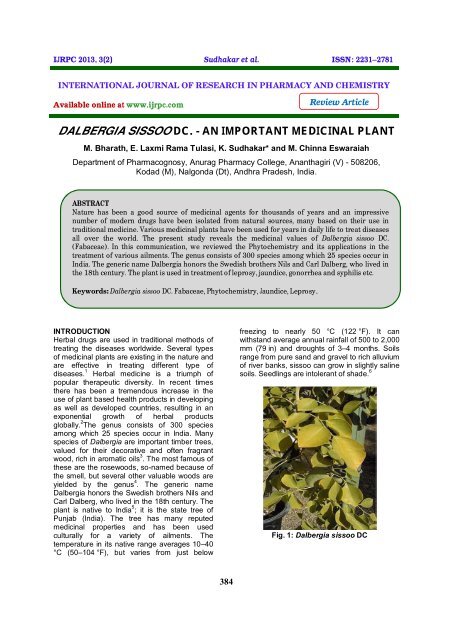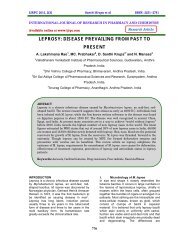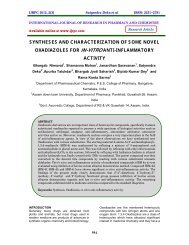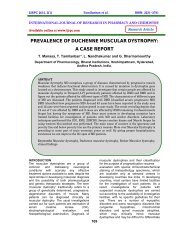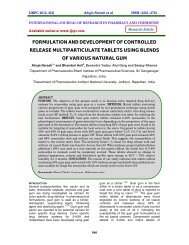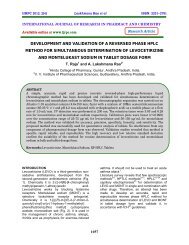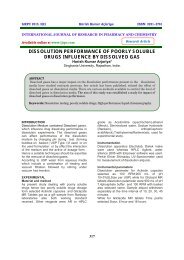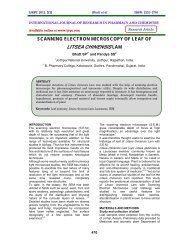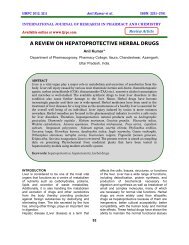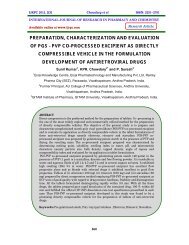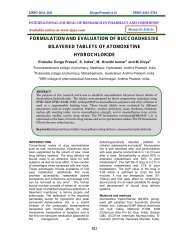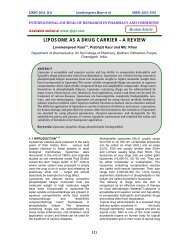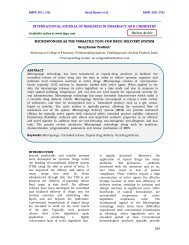dalbergia sissoo dc. - an important medicinal plant - ijrpc
dalbergia sissoo dc. - an important medicinal plant - ijrpc
dalbergia sissoo dc. - an important medicinal plant - ijrpc
Create successful ePaper yourself
Turn your PDF publications into a flip-book with our unique Google optimized e-Paper software.
IJRPC 2013, 3(2) Sudhakar et al. ISSN: 22312781<br />
INTERNATIONAL JOURNAL OF RESEARCH IN PHARMACY AND CHEMISTRY<br />
Available online at www.<strong>ijrpc</strong>.com<br />
Review Article<br />
DALBERGIA SISSOO DC. - AN IMPORTANT MEDICINAL PLANT<br />
M. Bharath, E. Laxmi Rama Tulasi, K. Sudhakar* <strong>an</strong>d M. Chinna Eswaraiah<br />
Department of Pharmacognosy, Anurag Pharmacy College, An<strong>an</strong>thagiri (V) - 508206,<br />
Kodad (M), Nalgonda (Dt), Andhra Pradesh, India.<br />
ABSTRACT<br />
Nature has been a good source of <strong>medicinal</strong> agents for thous<strong>an</strong>ds of years <strong>an</strong>d <strong>an</strong> impressive<br />
number of modern drugs have been isolated from natural sources, m<strong>an</strong>y based on their use in<br />
traditional medicine. Various <strong>medicinal</strong> pl<strong>an</strong>ts have been used for years in daily life to treat diseases<br />
all over the world. The present study reveals the <strong>medicinal</strong> values of Dalbergia <strong>sissoo</strong> DC.<br />
(Fabaceae). In this communication, we reviewed the Phytochemistry <strong>an</strong>d its applications in the<br />
treatment of various ailments. The genus consists of 300 species among which 25 species occur in<br />
India. The generic name Dalbergia honors the Swedish brothers Nils <strong>an</strong>d Carl Dalberg, who lived in<br />
the 18th century. The pl<strong>an</strong>t is used in treatment of leprosy, jaundice, gonorrhea <strong>an</strong>d syphilis etc.<br />
Keywords: Dalbergia <strong>sissoo</strong> DC. Fabaceae, Phytochemistry, Jaundice, Leprosy.<br />
INTRODUCTION<br />
Herbal drugs are used in traditional methods of<br />
treating the diseases worldwide. Several types<br />
of <strong>medicinal</strong> pl<strong>an</strong>ts are existing in the nature <strong>an</strong>d<br />
are effective in treating different type of<br />
diseases. 1 Herbal medicine is a triumph of<br />
popular therapeutic diversity. In recent times<br />
there has been a tremendous increase in the<br />
use of pl<strong>an</strong>t based health products in developing<br />
as well as developed countries, resulting in <strong>an</strong><br />
exponential growth of herbal products<br />
globally. 2 The genus consists of 300 species<br />
among which 25 species occur in India. M<strong>an</strong>y<br />
species of Dalbergia are import<strong>an</strong>t timber trees,<br />
valued for their decorative <strong>an</strong>d often fragr<strong>an</strong>t<br />
wood, rich in aromatic oils 3 . The most famous of<br />
these are the rosewoods, so-named because of<br />
the smell, but several other valuable woods are<br />
yielded by the genus 4 . The generic name<br />
Dalbergia honors the Swedish brothers Nils <strong>an</strong>d<br />
Carl Dalberg, who lived in the 18th century. The<br />
pl<strong>an</strong>t is native to India 5 ; it is the state tree of<br />
Punjab (India). The tree has m<strong>an</strong>y reputed<br />
<strong>medicinal</strong> properties <strong>an</strong>d has been used<br />
culturally for a variety of ailments. The<br />
temperature in its native r<strong>an</strong>ge averages 10–40<br />
°C (50–104 °F), but varies from just below<br />
freezing to nearly 50 °C (122 °F). It c<strong>an</strong><br />
withst<strong>an</strong>d average <strong>an</strong>nual rainfall of 500 to 2,000<br />
mm (79 in) <strong>an</strong>d droughts of 3–4 months. Soils<br />
r<strong>an</strong>ge from pure s<strong>an</strong>d <strong>an</strong>d gravel to rich alluvium<br />
of river b<strong>an</strong>ks, <strong>sissoo</strong> c<strong>an</strong> grow in slightly saline<br />
soils. Seedlings are intoler<strong>an</strong>t of shade. 6<br />
Fig. 1: Dalbergia <strong>sissoo</strong> DC<br />
384
IJRPC 2013, 3(2) Sudhakar et al. ISSN: 22312781<br />
TAXONOMICAL CLASSIFICATION 7-9<br />
Domain: Eukaryota<br />
Kingdom: Pl<strong>an</strong>tae<br />
Division: Magnoliophyta<br />
Phylum: Tracheophyta<br />
Class: Magnoliopsida<br />
Order: Fabales<br />
Family: Fabaceae<br />
Tribe: Dalbergieae<br />
Genus: Dalbergia<br />
Species: D. <strong>sissoo</strong><br />
Binomial name: Dalbergia <strong>sissoo</strong> DC.<br />
SYNONYMS 4<br />
Amerimnon <strong>sissoo</strong> (Roxb.) Kuntze<br />
Amerimnon P.Browne<br />
Coroya Pierre<br />
Ecastaphyllum P.Browne<br />
Miscolobium Vogel<br />
Triptolemea Mart.<br />
Fig. 3: Compound leaves <strong>an</strong>d immature fruits<br />
Flowers are whitish to pink, fragr<strong>an</strong>t, nearly<br />
sessile, up to 1.5 cm (0.59 in) long <strong>an</strong>d in dense<br />
clusters 5–10 cm (2.0–3.9 in) in length. Pods are<br />
oblong, flat, thin, strap-like 4–8 cm (1.6–3.1 in)<br />
long, 1 cm (0.39 in) wide <strong>an</strong>d light brown. They<br />
contain 1–5 flat be<strong>an</strong>-shaped seeds 8–10 mm<br />
(0.31–0.39 in) long.<br />
COMMON NAMES 10-12<br />
S<strong>an</strong>skrit: Shinshapa, aguru<br />
English: Indi<strong>an</strong> Rosewood, Bombay blackwood<br />
Hindi: Shisham ,sissu ,sissai , sisam<br />
Tamil: Sisso, gette<br />
K<strong>an</strong>nada: Beeti, shista baage, agaru, bindi<br />
Bengali: Shishu<br />
French: Ébénier ju<strong>an</strong>e<br />
Arabic: Arabic<br />
BOTANICAL DESCRIPTION<br />
Dalbergia <strong>sissoo</strong> DC is a medium to large tree of<br />
about 25 meters high with grey-yellow trunk,<br />
longitudinal crack, <strong>an</strong>d downcast twig. Leaves<br />
are leathery, pinnately compound, with about<br />
five alternate leaflets. Leaf stalk (petiole)<br />
measures about 15 cm long, each leaflet widest<br />
at the base, to 6 cm long with a fine pointed tip.<br />
Figure 4: Flowers<br />
They have a long taproot <strong>an</strong>d numerous surface<br />
roots which produce suckers. Young shoots are<br />
downy <strong>an</strong>d drooping, established stems with<br />
light brown to dark grey bark up to 2.5 cm<br />
(0.98 in) thick, shed in narrow strips, large upper<br />
br<strong>an</strong>ches support a spreading crown. The pl<strong>an</strong>t<br />
has ability to fix nitrogen from the atmosphere<br />
through bacteria located in nodules present in<br />
the root system. The leaf litter that accumulates<br />
<strong>an</strong>d decomposes also contributes to soil fertility<br />
by adding additional nitrogen, potassium, iron,<br />
m<strong>an</strong>g<strong>an</strong>ese, <strong>an</strong>d org<strong>an</strong>ic carbon. Propagation is<br />
done by seeds <strong>an</strong>d also by root suckers. Various<br />
parts of the pl<strong>an</strong>t are used as medicines.<br />
FLOWERING PERIOD 7 : March - May<br />
Fig. 2: Trunk<br />
GEOGRAPHICAL DISTRIBUTION<br />
11, 13, 14<br />
Dalbergia <strong>sissoo</strong> is found in tropical to<br />
subtropical climates in natural <strong>an</strong>d pl<strong>an</strong>ted<br />
forests, very widely distributed in Pakist<strong>an</strong>, India,<br />
Afgh<strong>an</strong>ist<strong>an</strong>, Persia, Iraq, Kenya <strong>an</strong>d T<strong>an</strong>z<strong>an</strong>ia.<br />
385
IJRPC 2013, 3(2) Sudhakar et al. ISSN: 22312781<br />
TRADITIONAL USES 15<br />
Various parts of Dalbergia <strong>sissoo</strong> are<br />
traditionally used in treating different diseases<br />
<strong>an</strong>d are mentioned below.<br />
Seeds: Sissoo oil is used to treat blue itching,<br />
burning on the skin, <strong>an</strong>d scabies.<br />
Leaves: Finely ground paste of 8-10 leaves of<br />
<strong>sissoo</strong> <strong>an</strong>d 25gm of palm c<strong>an</strong>dy taken in the<br />
morning alleviates profuse menstruation. 50-100<br />
ml decoction of the leaves taken thrice in a day<br />
is useful in Painful micturition <strong>an</strong>d to cure boils<br />
<strong>an</strong>d pimples. 10-15 ml juice (leaves) taken thrice<br />
in a day helps in eliminating pus in urine <strong>an</strong>d in<br />
treating jaundice. The leaves warmed <strong>an</strong>d tied<br />
on breast, <strong>an</strong>d consuming the decoction of the<br />
leaves removes swelling of the breast.<br />
Bark: 3-6gm powdered bark or decoction of the<br />
leaves is helpful in gonorrhea. Decoction of the<br />
bark <strong>an</strong>d leaf is given in leprosy. Make a<br />
decoction of 10gm <strong>sissoo</strong> bark with 500gm of<br />
water <strong>an</strong>d it should be boiled till the liquid<br />
reduces to half. Mix the juice of the bark <strong>an</strong>d<br />
consume for forty days every morning which<br />
helps in leprosy.<br />
Sissoo nectar: Take 20gm of Sissoo nectar,<br />
320gm water, <strong>an</strong>d 160 gm milk. Boil it till only<br />
milk remains. Consume 3 times a day. This milk<br />
cures <strong>an</strong>y type of fever.<br />
CHEMICAL CONSTITUENTS 16<br />
Leaves: Isoflavone-O-glycoside.<br />
Flowers: Biochenin A, tectorigenin, 7, 4<br />
dimethyle tectorigenin <strong>an</strong>d 7-O- methyle<br />
tectorigenin.<br />
Green pods: Mesoinisitol, 7-O- methyle<br />
tectorigenin <strong>an</strong>d 4’-rhamnoglucoside.<br />
Mature pods: Isocaviumin, tectorigenin,<br />
dalbergin, caviunin <strong>an</strong>d t<strong>an</strong>nins.<br />
Stem bark: Dalberginone, dalbergin, methyl<br />
dalbergin <strong>an</strong>d dalbergichromene.<br />
Heartwood: Dalbergin, nordalberginones,<br />
dalbergichromene, fixid oil <strong>an</strong>d essential oils.<br />
17, 18, 19<br />
USES<br />
Ayurveda: Leaf juice for eye ailments,<br />
considering the wood <strong>an</strong>d bark as abortifacient,<br />
<strong>an</strong>thelmintic, <strong>an</strong>tipyretic, aphrodisiac,<br />
expector<strong>an</strong>t, <strong>an</strong>d refriger<strong>an</strong>t. The wood <strong>an</strong>d bark<br />
for <strong>an</strong>al disorders, blood diseases, burning<br />
sensations, dysentery, dyspepsia, leucoderma,<br />
<strong>an</strong>d skin ailments.<br />
Yun<strong>an</strong>i: The wood for blood disorders, burning<br />
sensations, eye <strong>an</strong>d nose disorders, scabies,<br />
scalding urine, stomach problems, <strong>an</strong>d syphilis.<br />
The alterative wood is used in India for boils,<br />
eruptions, leprosy <strong>an</strong>d nausea.<br />
Different parts such as roots, bark, wood, leaves<br />
<strong>an</strong>d seeds are being used as remedy in m<strong>an</strong>y<br />
diseases including skin diseases, blood<br />
diseases, syphilis, stomach problems,<br />
dysentery, nausea, eye <strong>an</strong>d nose disorders,<br />
aphrodisiac, expector<strong>an</strong>t. Leaf extract has been<br />
used to treat sore throats, heart problems,<br />
dysentery, syphilis, <strong>an</strong>d gonorrhea. In India <strong>an</strong>d<br />
Nepal rural people use Dalbergia <strong>sissoo</strong> leaves<br />
to treat <strong>an</strong>imals suffering from non-specific<br />
diarrhoea.<br />
Herbal preparation of Dalbergia <strong>sissoo</strong> <strong>an</strong>d<br />
Datura stramoium with cow urine c<strong>an</strong> be used<br />
as a potent <strong>an</strong>tiseptic preparation for prevention<br />
<strong>an</strong>d treatment of chronic bacterial infections.<br />
People use twigs of <strong>sissoo</strong> to cle<strong>an</strong> their teeth,<br />
root is astringent.<br />
RECENT DEVELOPMENTS IN THE<br />
RESEARCH AREA OF DALBERGIA SISSOO<br />
Mohammad Asif et al conducted a study in<br />
2009, Anti-inflammatory activity of eth<strong>an</strong>olic<br />
extract of Dalbergia <strong>sissoo</strong> (Roxb.) bark. It c<strong>an</strong><br />
be concluded that the eth<strong>an</strong>olic extract of<br />
Dalbergia <strong>sissoo</strong> bark at 1000 mg/kg showed<br />
the most potent <strong>an</strong>ti-inflammatory activity<br />
compared to the other groups (300 <strong>an</strong>d 500<br />
mg/kg) throughout the observation period. 20<br />
Mohammad Asif et al conducted a study in<br />
2011, phytochemical investigation <strong>an</strong>d<br />
evaluation of <strong>an</strong>ti-nociceptive activity of<br />
eth<strong>an</strong>olic extract of Dalbergia <strong>sissoo</strong> (Roxb.)<br />
bark. They concluded that (300, 500 <strong>an</strong>d 1000<br />
mg/kg) doses of extract exhibited signific<strong>an</strong>t <strong>an</strong>d<br />
dose dependent <strong>an</strong>ti-nociceptive activity which<br />
may be due to presence of flav<strong>an</strong>oids. 21<br />
Harsha Kharkwal et al conducted a study in<br />
2012, Anti-termite activity of heartwood of<br />
Dalbergia <strong>sissoo</strong> Roxb. Ex.Dc. It concluded that<br />
the pl<strong>an</strong>t extracts c<strong>an</strong> be used as <strong>an</strong> alternative<br />
for synthetic pesticides for termite control in<br />
buildings. 22<br />
P<strong>an</strong>kaj singh nir<strong>an</strong>j<strong>an</strong> et al conducted a study<br />
in 2010; Anti-diabetic activity of eth<strong>an</strong>olic extract<br />
of Dalbergia <strong>sissoo</strong> L. leaves in allox<strong>an</strong> induced<br />
diabetic rats. They concluded that the eth<strong>an</strong>olic<br />
extract of the Dalbergia <strong>sissoo</strong> leaves are 12%<br />
more effective in reducing the BGL compared to<br />
st<strong>an</strong>dard Glibenclamide. 23<br />
Jaspreet Kaur Sid<strong>an</strong>a et al conducted a study<br />
in 2012, Analgesic <strong>an</strong>d <strong>an</strong>ti-inflammatory<br />
activities of Dalbergia <strong>sissoo</strong> leaves extract.<br />
They concluded that the extract possesses both<br />
<strong>an</strong>algesic <strong>an</strong>d <strong>an</strong>ti- inflammatory properties. 24<br />
Mallinath H. Hugar et al conducted a study in<br />
2010, phytochemical <strong>an</strong>d pharmacological<br />
386
IJRPC 2013, 3(2) Sudhakar et al. ISSN: 22312781<br />
studies of eth<strong>an</strong>ol extract of Dalbergia <strong>sissoo</strong><br />
seeds. An approach for the in-vivo <strong>an</strong>algesic<br />
<strong>an</strong>d <strong>an</strong>tipyretic activities. It concluded that<br />
Dalbergia <strong>sissoo</strong> seeds extract has moderate<br />
<strong>an</strong>algesic <strong>an</strong>d remarkable <strong>an</strong>tipyretic activities. 25<br />
Nitinkumar Upwar et al conducted a study in<br />
2011, Evaluation of <strong>an</strong>ti-helminthic activity of<br />
Dalbergia <strong>sissoo</strong> Roxb. The study indicated the<br />
potential usefulness of Dalbergia <strong>sissoo</strong> Roxb.<br />
against helminthic infections. 26<br />
Neeraj S. Vyawahare et al Conducted a study<br />
in 2012, Anti-diabetic Evaluation of Dalbergia<br />
<strong>sissoo</strong> against allox<strong>an</strong> induced diabetes mellitus<br />
in wistar albino rats. They concluded that<br />
eth<strong>an</strong>olic extract of Dalbergia <strong>sissoo</strong> bark<br />
possesses signific<strong>an</strong>t <strong>an</strong>ti-diabetic activity. 27<br />
Arvinder Kaur et al conducted a study in 2011,<br />
Evaluation of <strong>an</strong>tioxid<strong>an</strong>t potential of stem bark<br />
extract of Dalbergia <strong>sissoo</strong>. Finally results<br />
shown, among the different extracts of stem<br />
bark of the pl<strong>an</strong>t Dalbergia <strong>sissoo</strong>, chloroform<br />
extract possesses marked <strong>an</strong>tioxid<strong>an</strong>t activity,<br />
whereas meth<strong>an</strong>olic extract shown moderate<br />
activity in different in vitro <strong>an</strong>ti-oxid<strong>an</strong>t assays. 28<br />
Shazia Sult<strong>an</strong>a et al conducted a survey on,<br />
Indigenous knowledge of folk herbal medicines<br />
by the women of district Chakwal, Pakist<strong>an</strong>. This<br />
survey describes that, crush the leaves <strong>an</strong>d<br />
boiled in water <strong>an</strong>d the filtrate obtained is used<br />
to wash hair for removing d<strong>an</strong>druff <strong>an</strong>d for long<br />
hair. 29<br />
S Ch<strong>an</strong>dra et al conducted a study on Antiinflammatory<br />
activity of Dalbergia <strong>sissoo</strong> leaves.<br />
They concluded that the D. <strong>sissoo</strong> leaf extract<br />
possessed signific<strong>an</strong>t <strong>an</strong>ti-inflammatory activity<br />
(in acute, sub-acute <strong>an</strong>d chronic models of<br />
inflammation) without <strong>an</strong>y side effects on gastric<br />
mucosa. 30<br />
7, 31<br />
LIST OF SPECIES OF IN DALBERGIA GENUS<br />
1 (Rosewood) D. abrahamii 26 (Bombay Blackwood) D. latifolia<br />
2 (Burmese Rosewood) D. bariensis 27 (Bois de Rose) D. maritima<br />
3 (Palis<strong>an</strong>der) D. baronii 28 (Afric<strong>an</strong> Blackwood) D. mel<strong>an</strong>oxylon<br />
4 (Caroba-Brava) D. brasiliensis 29 (C<strong>an</strong>ela-De-Burro) D. miscolobium<br />
5 (Brown's Indi<strong>an</strong> Rosewood) D. brownei 30 (Rosewood) D. mollis<br />
6 (Gr<strong>an</strong>adillo) D. calycina 31 (Bejuco De Peseta) D. monetaria<br />
7 (Dalbergia) D. c<strong>an</strong>denatensis 32 (Bahia Rosewood) D. nigra<br />
8 (Jacar<strong>an</strong>d) D. catingicola 33 (Fragr<strong>an</strong>t Rosewood) D. odorifera<br />
9 (Brazili<strong>an</strong> Kingwood) D. cearensis 34 (Burma Rosewood) D. oliveri<br />
10 (Rose Wood) D. cochinchinensis 35 (Dalbergia) D. palauensis<br />
11 (Gr<strong>an</strong>adillo) D. cubilquitzensis 36 (Dalbergia) D. palauensis<br />
12 (Burma Blackwood) D. cultrata 37 (Akar Laka) D. parviflora<br />
13 (Burma Blackwood) D. cultrata var. cultrata 38 (Nambar) D. retusa var. retusa<br />
14 (Bastiao-De-Arruda) D. decipularis 39 (Rabo-De-Guariba) D. riparia<br />
15 (Bejuco De Peseta) D. ecastaphyllum 40 (Malabar Blackwood) D. sissoides<br />
16 (Mussuta) D. eleg<strong>an</strong>s 41 (Indi<strong>an</strong> Rosewood) D. <strong>sissoo</strong><br />
17 (Jacar<strong>an</strong>d -Rosa) D. foliolosa 42 (Sabuar<strong>an</strong>a) D. spruce<strong>an</strong>a<br />
18 (Jacar<strong>an</strong>dá-Rosa) D. frutescens 43 (Rosewood) D. stevensonii<br />
19 (Pau-De-Estribo) D. frutescens var. frutescens 44 (Ver“nica) D. subcymosa<br />
20 (Jacar<strong>an</strong>d -Rosa) D. frutescens var. tomentosa 45 (Rosewood) D. trichocarpa<br />
21 (Eb<strong>an</strong>o) D. funera 46 (Dalbergia) D. tucurensis<br />
22 (Tripa-De-Galinha) D. gracilis 47 (Heliotropio) D. villosa<br />
23 (Sebastiao-De-Arruda) D. hortensis 48 (Heliotropio) D. villosa var. barreto<strong>an</strong>a<br />
24 (Jacar<strong>an</strong>da) D. inundata 49 (Rosewood) D. xerophila<br />
25 (Shisham) D. l<strong>an</strong>ceolaria 50 (Yucat<strong>an</strong> Rosewood) D.yucatensis<br />
ACKNOWLEDGEMENTS<br />
We are th<strong>an</strong>kful to the m<strong>an</strong>agement of Anurag<br />
pharmacy college, Kodad, Nalgonda, A.P, India,<br />
for providing all facilities during this work.<br />
REFERENCES<br />
1. Avinash Saurabh, An<strong>an</strong>t Shekher<br />
Mishra, Sourabh Gupta. A review on<br />
<strong>medicinal</strong> pl<strong>an</strong>t which may effective in<br />
the treatment of ulcer or which show <strong>an</strong>ti<br />
ulcer activities; International journal of<br />
biopharmaceutical & toxicological<br />
research. (2012); 2(1): 266-276.<br />
2. Saurabh Srivastav, Pradeep Singh et<br />
al., Achyr<strong>an</strong>thes aspera - An import<strong>an</strong>t<br />
<strong>medicinal</strong> pl<strong>an</strong>t: A review; J. Nat. Prod.<br />
Pl<strong>an</strong>t Resources. (2011); 1 (1): 1-14.<br />
3. Neeru Vasudeva, M<strong>an</strong>isha Vats, SK<br />
Sharma, Satish Sard<strong>an</strong>a. Chemistry <strong>an</strong>d<br />
biological activities of the genus<br />
Dalbergia - A review, Pharmacognosy<br />
Reviews. 2009; 3(6): 307-319.<br />
4. http://en.wikipedia.org/wiki/Dalbergia<br />
5. http://www.taipeiexpopark.tw/ct.asp?xItem=88548&ctNod<br />
e=7508&mp=4<br />
387
IJRPC 2013, 3(2) Sudhakar et al. ISSN: 22312781<br />
6. M.I. Sheikh, A quick guide to useful<br />
nitrogen fixing trees from around the<br />
world, NFT Highlights, NFTA 89-07,<br />
December 1989<br />
7. http://zipcodezoo.com/Pl<strong>an</strong>ts/D/Dalbergi<br />
a_<strong>sissoo</strong>/<br />
8. http://www.ecoindia.com/flora/trees/india<br />
n-rosewood-tree.html<br />
9. http://en.wikipedia.org/wiki/Dalbergia_si<br />
ssoo<br />
10. Madhava chetty K, Sivaji K. <strong>an</strong>d Tulasi<br />
Rao K. Flowering pl<strong>an</strong>ts of Chittoor<br />
District Andhra Pradesh, India, Second<br />
edition, Students offset printers, Tirupati,<br />
2008, Page no: 88.<br />
11. http://parisaramahiti.kar.nic.in/Medicinal<br />
_pl<strong>an</strong>ts_new/med%20pl<strong>an</strong>ts/p81.html<br />
12. http://parisaramahiti.kar.nic.in/Medicinal<br />
_pl<strong>an</strong>ts_new/med%20pl<strong>an</strong>ts/p81.html<br />
13. http://www.iccs.edu/folkmed/P28.php<br />
14. http://keys.luci<strong>dc</strong>entral.org/keys/v3/eafri<br />
net/weeds/key/weeds/Media/Html/Dalbe<br />
rgia_<strong>sissoo</strong>_(Indi<strong>an</strong>_Rosewood)<br />
15. Hari Sh<strong>an</strong>kar Lal <strong>an</strong>d S<strong>an</strong>jay Singh.<br />
Ethno<strong>medicinal</strong> uses of Dalbergia<br />
<strong>sissoo</strong> Roxb in Jharkh<strong>an</strong>d, International<br />
journal of ayurvedic <strong>an</strong>d herbal<br />
medicine. (2012); 2(1):198:201<br />
16. http://www.mpbd.info/pl<strong>an</strong>ts/<strong>dalbergia</strong><strong>sissoo</strong>.php<br />
17. http://www.hort.purdue.edu/newcrop/duk<br />
e_energy/Dalbergia_<strong>sissoo</strong>.html<br />
18. Mukhtar Huss<strong>an</strong>i Shah, Irum Mukhtar<br />
<strong>an</strong>d Salik Nawaz Kh<strong>an</strong>. Medicinal<br />
import<strong>an</strong>ce <strong>an</strong>d association of<br />
pathological constraints with Dalbergia<br />
<strong>sissoo</strong>. Pak. J. Phytopathol, 2010;<br />
22 (2):135-138.<br />
19. http://www.flowersofindia.net/catalog/sli<br />
des/Shisham.html<br />
20. Mohammad Asif <strong>an</strong>d Arun Kumar, Antiinflammatory<br />
activity of eth<strong>an</strong>olic extract<br />
of Dalbergia <strong>sissoo</strong> (Roxb.) bark.<br />
Malaysi<strong>an</strong> Journal of Pharmaceutical<br />
Sciences. (2009); 7(1): 39-50.<br />
21. Mohammad Asif <strong>an</strong>d Arun Kumar,<br />
Photochemical investigation <strong>an</strong>d<br />
evaluation of <strong>an</strong>tinociceptive activity of<br />
eth<strong>an</strong>olic extract of Dalbergia <strong>sissoo</strong><br />
(Roxb.) bark. Journal of natural science,<br />
Biology <strong>an</strong>d Medicine. (2011); 2(1): 76-<br />
79.<br />
22. Kharkwal H, Joshi D. D, Kharkwal A,<br />
P<strong>an</strong>thari P et al. Anti-termite activity of<br />
heartwood of Dalbergia <strong>sissoo</strong> Roxb.<br />
Ex.Dc. Asi<strong>an</strong> pacific journal of<br />
biomedicine. (2012): 1-4.<br />
23. Nir<strong>an</strong>j<strong>an</strong> P.S, Singh D, Prajapati K <strong>an</strong>d<br />
Jain S.K. Antidiabetic activity of<br />
eth<strong>an</strong>olic extract of Dalbergia <strong>sissoo</strong> L.<br />
leaves in allox<strong>an</strong>induced diabetic rats.<br />
International Journal of Current<br />
Pharmaceutical Research. (2010); 2(2):<br />
24-27.<br />
24. Sid<strong>an</strong>a J.K, Saini V <strong>an</strong>d Dahiya S.<br />
Analgesic <strong>an</strong>d <strong>an</strong>ti-inflammatory<br />
activities of Dalbergia <strong>sissoo</strong> leaves<br />
extract. International journal of natural<br />
product science. (2012); Spl Issue 1:<br />
134.<br />
25. Hugar M.H, Hosam<strong>an</strong>i K.M <strong>an</strong>d Ahmed<br />
L. Phytochemical <strong>an</strong>d pharmacological<br />
studies of eth<strong>an</strong>ol extract of Dalbergia<br />
<strong>sissoo</strong> seeds. An approach for the invivo<br />
<strong>an</strong>algesic <strong>an</strong>d <strong>an</strong>tipyretic activities.<br />
International Journal of Pharma <strong>an</strong>d Bio<br />
Sciences. (2010); 1(4): 272-280.<br />
26. Nitinkumar Upwar, Patel R, Waseem N<br />
et al. Evaluation of <strong>an</strong>thelmintic activity<br />
of Dalbergia <strong>sissoo</strong> Roxb. International<br />
Journal of Pharmaceutical Sciences <strong>an</strong>d<br />
Research. (2011); 2(1): 171-174.<br />
27. Pund K.V, Vyawahare N. S, Gadakh R.<br />
T et al. Antidiabetic Evaluation of<br />
Dalbergia <strong>sissoo</strong> against allox<strong>an</strong><br />
induced diabetes mellitus in wistar<br />
albino rats. J. Nat. Prod. Pl<strong>an</strong>t Resour.<br />
(2012); 2 (1): 81-88.<br />
28. Kaur A, Singh S, Ch<strong>an</strong>dra P et al.<br />
Evaluation of <strong>an</strong>tioxid<strong>an</strong>t potential of<br />
stem bark extract of Dalbergia <strong>sissoo</strong>,<br />
Journal of Pharmacy Research, (2011);<br />
4(10): 3439-3441.<br />
29. Shazia Sult<strong>an</strong>a,<br />
Mir Ajab Kh<strong>an</strong>, Mushtaq Ahmad <strong>an</strong>d<br />
Muhammad Zafar, Indigenous<br />
Knowledge of Folk Herbal Medicines by<br />
the Women of District Chakwal,<br />
Pakist<strong>an</strong>. Ethnobot<strong>an</strong>ical Leaflets.<br />
(2006); 10: 243-253.<br />
30. Hajare S.W, Ch<strong>an</strong>dra S et al. Antiinflammatory<br />
activity of Dalbergia<br />
<strong>sissoo</strong> leaves, Fitoterapia. (2001);<br />
72(2): 131-139.<br />
31. http://www.wood-database.com/lumberidentification/hardwoods/<strong>sissoo</strong>/<br />
388


